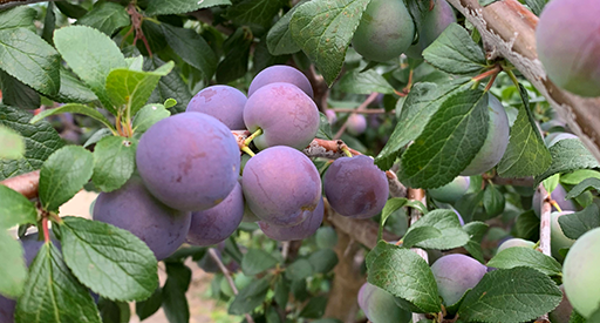
By keeping your trees actively growing, well-fed, consistently watered, mulched through summer and winter, and pruned at the right time, you should have healthy plants.
However, sometimes Mother Nature is against us with things like weather or growing conditions, and so we need to take action.
Different varieties of fruit trees are susceptible to different diseases. There are varieties that are disease resistant, or less susceptible to insect pests than others. Check with your local garden centre or grower for the best trees for your region.
General Clean-up
Winter is the time for clean up sprays on all fruit trees. Use a plant spraying oil to capture any overwintering insect eggs which hide in leaf buds and in bark. Mix this with a copper oxychloride spray to get any overwintering fungal spores. Oil and copper based spray applications are protectant sprays so are good to apply as a general clean up and can be done through winter up to bud burst in spring.
Fungal Diseases
Broad-spectrum fungicides can be applied early in the season for the following diseases:
- Brown spot
- Scab
- Black spot
- Botrytis.
Often these diseases appear when conditions are cool and wet, or warm and humid.
Leaf curl always appears early in the season and lasts for several weeks. To control leaf curl use a copper based spray that is non toxic to bees as a preventative over winter, before bud burst in spring and then two weeks after bud burst. Collecting up the fallen leaves will also help minimise leaf curl in the following season.
Insect Pests
Insecticide sprays will control most common insect pests that affect fruit trees. They need to be applied after petal fall to protect foraging bees and other pollinators. Spray 14 days after petal fall and then again in the middle of summer to capture the second generation.
Use pheromone traps for pests such as codling moth and guava moth that burrow into fruit, when they are placed on the tree is critical for effective control.
- For codling moth place the traps in trees in September/October, the timing is important. Codling moth overwinter and have a dormant period.
- For guava moth, place them in the trees when fruit first set and keep them there until fruiting has finished, they do not have a dormant period so will find other hosts in winter.
Check with your local garden centre for a suitable spray for your fruit trees, there are also natural and non-toxic options available. By having good growing practices you will minimise the amount of spray required.
Tui Tips
- Take care not to spray when trees are in blossom, and spraying early in the morning is preferable to later in the day when bees are present.
- Take care not to spray on a windy day to minimise spray drift.
- Collect up fallen leaves, keeping the area weed free. Dispose of any infected plant material in the rubbish and not the compost.
- Replenishing nutrients used by your fruit trees ensures they will grow to their full potential, improving flowering and fruiting so they produce abundant and juicy crops. Use Tui Performance Organics Citrus & Fruit fertiliser to feed your fruit trees planted in the garden or in pots and containers. Feed during the key growth times of spring, summer and autumn.
- Protect your trees from the elements with layers of mulch. Add a layer of Tui Mulch & Feed about 50mm deep around fruit trees to suppress weeds and help conserve moisture. Be careful not to leave the mulch touching the trunk/stem of the plants as this can cause rot.
Post a comment
Fruit Tree Spraying Guide Comments
Hi, what is the best product to use for rust. Every year without fail it gets my iris, gladioli and garlic. Help.
Linda Gigger
Hi Linda, rust is a hard fungus to control once it take hold and spreads easily. Remove infected leaves from the plant, clear up fallen leaves around plants and destroy as the fungal spores will sit in the soil until conditions are favourable. Rust enjoys wet, moist conditions and so try to avoid overhead watering (hard to do with all of this rain) or splashing water on the leaves when watering, also improve air circulation around your plants as prevention is the best form of defense against rust. Some plants are more susceptible than others, so planting rust free varieties will also help. There are sprays that can be effective as a preventative such as copper based sprays, flowers of sulphur may also help if you lift your bulbs in autumn, dust them with flowers of sulphur which is a natural fungicide. If you need to spray, then talk to your local garden centre or DIY store for a suitable control, there are natural options available suitable for edible crops such as garlic. Make sure your soil is well nourished with organic matter such as compost, straw, rotted lawn clippings, sheep manure pellets to name a few. Apply a balanced fertiliser, look for one that is enriched with calcium and magnesium for healthy bulbs, Tui Vegetable Food or Tui Bulb Food is suitable, apply every 4-6 weeks in the growing season. By keeping your plants well fed and actively growing, and your soil replenished with organic matter, you are helping to boost plants resistance to pest and disease. Tui Seaweed Plant Tonic is also helpful in keeping plants actively growing and helps reduce plants susceptibility to pests and disease.
Lianne, Tui Team